Related Research Articles
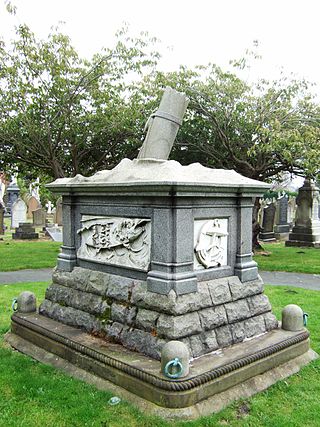
The Southport and St Anne's lifeboats disaster, commonly known as the Mexico disaster, occurred on the evening of the 9th December 1886. In all, 27 lifeboat men lost their lives trying to save the crew of the German barque called the Mexico.

Walmer Lifeboat Station was established in 1830. Over two thousand ships are believed to have been wrecked on the Goodwin Sands, and the masts of several wrecks are visible from the shore at low tide. Hence there have always been two lifeboats located at the joined towns of Deal and Walmer along the coast opposite the sands.
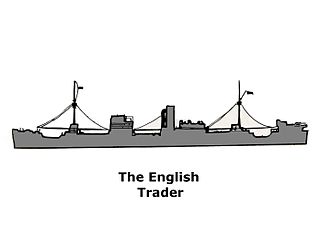
The SS English Trader was a British merchant ship wrecked off the coast of Norfolk, England in October 1941. After falling behind a convoy during the Second World War of which she was a part, the ship ran aground on the Hammond's Knoll sandbank and began to break up during a gale. Several rescue attempts by lifeboats failed, but a further attempt the following day by the Cromer Lifeboat rescued 44 of the crew, three having already been lost.
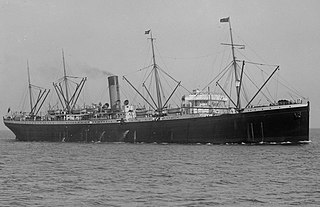
SS Suevic was a steamship built by Harland and Wolff in Belfast for the White Star Line. Suevic was the fifth and last of the Jubilee-class ocean liners, built specifically to service the Liverpool-Cape Town-Sydney route, along with her sister ship Runic. In 1907 she was wrecked off the south coast of England, but in the largest rescue of its kind, all passengers and crew were saved. The ship herself was deliberately broken in two, and a new bow was attached to the salvaged stern portion. Later serving as a Norwegian whaling factory ship carrying the name Skytteren, she was scuttled off the Swedish coast in 1942 to prevent her capture by ships of Nazi Germany.
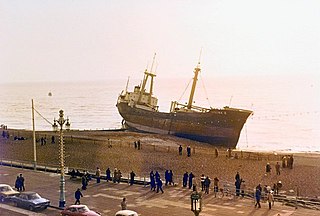
The Athina B was a merchant ship. On 21 January 1980 she suffered engine failure in bad weather and beached at the English seaside resort of Brighton, to the east of the town's Palace Pier. The ship was a temporary tourist attraction, with the Volk's Electric Railway opening out of season to serve the large number of sightseers. The anchor of the ship is on display on Brighton seafront. A restaurant in Brighton bears the name of the ship and a painting of Athena B by Dennis Roxby Bott is in Brighton Museum.
A rescue lifeboat is a boat rescue craft which is used to attend a vessel in distress, or its survivors, to rescue crew and passengers. It can be hand pulled, sail powered or powered by an engine. Lifeboats may be rigid, inflatable or rigid-inflatable combination-hulled vessels.
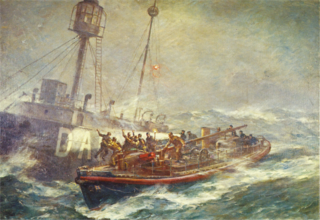
RNLB Mary Stanford was the Ballycotton Lifeboat from 1930 to 1959. Ballycotton is on Ireland's southern coast, a trade route to the Americas. There are many dangerous rocks and shallows with on-shore prevailing winds. Ballycotton has a long tradition of life-saving. Mary Stanford had 41 rescues, or "shouts", and saved 122 lives. She performed the notable Daunt Lightship rescue on 11 February 1936. After her withdrawal from service she lay for some years in a backwater of Dublin's Grand Canal Dock, but has now been returned to Ballycotton and restored.
Over the years, a number of ships have foundered off Southport. For the purposes of this article, the Southport area shall be considered as Southwards from Lytham St Annes to Freshfield.

SS Monte Nevoso was a cargo steamship that was launched in 1920 in England, owned in Italy, and wrecked in 1932 in the North Sea off the coast of Norfolk.
SS Gallois was one of seven merchant vessels which became stranded and then wrecked on Haisbro Sands of the Norfolk coast on 6 August 1941 during the Second World War. The SS Gallois had been part of a convoy with the designation Convoy FS 559.
Walter L M Russ was a 1,538 GRT cargo ship built in 1927 in Rostock, Germany. In 1945, she was seized by the Allies and passed to the Ministry of War Transport (MoWT). It was intended that she would be renamed Empire Concourse but in July 1945 she ran aground between Wales and Ireland, and was wrecked.

Salcombe Lifeboat Station is the base for Royal National Lifeboat Institution (RNLI) search and rescue operations at Salcombe, Devon in England. The first lifeboat was stationed in the town in 1869. The Salcombe Lifeboat has twice capsized, in 1916 with the loss of 13 lives, and in 1983 with no loss of life. Since 2008 the station has operated a Tamar-class all weather boat (ALB) and an Atlantic 75 inshore lifeboat (ILB).

Torbay Lifeboat Station is the base for Royal National Lifeboat Institution (RNLI) search and rescue operations at Brixham, Devon in England. Brixham Lifeboat Station was opened in 1866 but since 1924 has been known as 'Torbay'. Since 2005 it has operated a Severn-class all-weather lifeboat (ALB) together with a D-class (IB1) inshore lifeboat (ILB).

Henry Ramey Upcher was the second private lifeboat to be stationed in the English town of Sheringham in the county of Norfolk. She was launched on 4 September 1894 and stayed on station for 41 years until she was slowly retired from duty and by 1935 had ceased rescue work completely. The lifeboat is now on permanent display in her own museum housed in her converted original boat shed.

RNLB Emma Constance was a Barnett-class lifeboat stationed at Aberdeen Lifeboat Station, in the Scottish city of Aberdeen from 1927 until August 1951. The lifeboat was designed by James R. Barnett who was a consulting naval architect to the Royal National Lifeboat Institution (RNLI).

Eastbourne Lifeboat Station is a Royal National Lifeboat Institution (RNLI) lifeboat station in the town of Eastbourne in East Sussex. Founded two years before the RNLI was established, the station has operated continuously since 1822 and its lifeboats have been responsible for saving over 700 lives. There are two active lifeboat stations in Eastbourne, an all-weather station with the Tamar-class lifeboatDiamond Jubilee at Sovereign Harbour and the D-class Lawrence and Percy Hobbs at the inshore lifeboat station a couple of miles to the west at Fisherman's Green. An older lifeboat station, west of Eastbourne Pier, is now used as an RNLI museum.

Whitby Lifeboat Station is a Royal National Lifeboat Institution (RNLI) lifeboat station located in Whitby, North Yorkshire, England. It is one of nine situated along the Yorkshire coast. Whitby has had a lifeboat station since 1802, with the RNLI responsible since 1861. In its 200 plus year history, Whitby has had five different lifeboat stations. A sixth lifeboat and station was located at Upgang, just up the coast from Whitby, and whilst it was considered separate from Whitby, it was crewed by men from the Whitby lifeboat.

Redcar Lifeboat Station is a Royal National Lifeboat Institution (RNLI) lifeboat station based in the town of Redcar in North Yorkshire, England. The station is the furthest north in Yorkshire.
SS Ben Doran was a steam fishing trawler that operated out of Aberdeen, Scotland. It was launched in 1900 and operated until its wrecking on the Ve Skerries, Shetland, on 29 March 1930, which claimed the lives of the full crew, believed to number nine crew members. Its wrecking has been called "the most tragic wreck in all Shetland's history".
References
- 1 2 O’Rourke, Mick. "Steamship Alondra Ran Aground Kedge Rock Baltimore Co Cork".
- 1 2 "About RNLI Baltimore Lifeboat Station". www.baltimorelifeboat.ie. Retrieved 25 October 2014.
- 1 2 "Scuba Diving in Baltimore, County Cork, Ireland, Europe". Dive Site Directory.
- ↑ Broderick, Sheelagh. "Filming of 1916 SS Alondra rescue finished".
- 1 2 3 "Exhibition to commemorate daring rescue off Cork coast". Irish Examiner.
- ↑ McAloon, Nuala. "Baltimore lifeboat rescue to feature in RNLI's World War One exhibition".
- ↑ McAloon, Nuala (10 October 2013). "Baltimore lifeboat rescue to feature in RNLI's World War One exhibition". Royal National Lifeboat Institution. Retrieved 25 October 2014.
- ↑ Broderick, Sheelagh. "Filming of 1916 SS Alondra rescue finished".